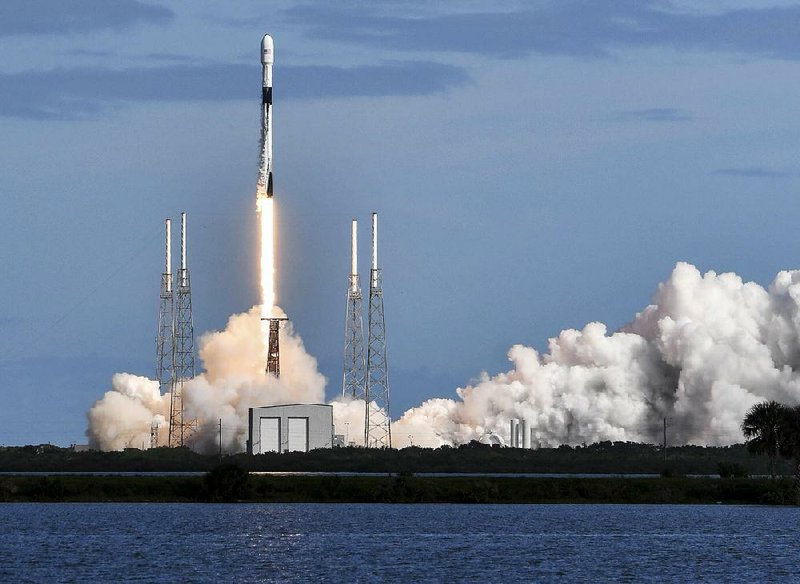CAPE CANAVERAL, Fla. -- SpaceX launched 60 mini satellites Monday, the second batch of an orbiting network meant to provide global internet coverage.
The Falcon rocket blasted into the morning sky, marking the unprecedented fourth flight of a booster for SpaceX. The compact flat-panel satellites -- just 575 pounds each -- will join 60 launched in May.
SpaceX founder and chief executive Elon Musk wants to put thousands of the Starlink satellites in orbit, to offer high-speed internet service everywhere. He plans to start service next year in the northern U.S. and Canada, with global coverage for populated areas after 24 launches of 60 satellites each.
Last month, Musk used an orbiting Starlink satellite to send a tweet: "Whoa, it worked!!"
Employees gathered at company bases on both coasts cheered when the first-stage booster, which flew in three previous missions, landed on a floating platform in the Atlantic about 8 1/2 minutes after the launch.
"These boosters are designed to be used 10 times. Let's turn it around for a fifth, guys," the company's launch commentator said.
This also marked the first time SpaceX used a previously flown nose cone. The California-based company reuses rocket parts to cut costs.
[Video not loading above? Click here to watch » https://www.youtube.com/watch?v=oLbKGGS67Dg]
Stacked flat inside the top of the rocket, the newest satellites were going to maneuver even higher after liftoff, using krypton-powered thrusters. SpaceX said there was a potential problem with one of the 60 that could prevent it from moving beyond its initial 174 mile-high orbit. In that case, the faulty satellite will be commanded to re-enter and burn up harmlessly in the atmosphere.
Each satellite has an autonomous system for dodging space junk. In September, however, the European Space Agency had to move one of its satellites out of the way of a Starlink satellite. SpaceX later said it corrected the problem.
The federal government has approved SpaceX for about 12,000 satellites for Starlink.
Musk has called Starlink "one of the hardest engineering projects" he's ever seen.
SpaceX is among several companies interested in providing broadband internet coverage worldwide, especially in areas where it costs too much or is unreliable. Others include OneWeb and Jeff Bezos' Amazon.com.
A space-based internet service will be an important source of funding for the closely held company, according to Musk, who founded SpaceX in 2002 with the ultimate goal of enabling people to live on other planets.
"We see this as a way for SpaceX to generate revenue that can be used to develop more advanced rockets and spaceships," Musk told journalists during a conference call in May. "This is a key stepping stone on the way toward establishing a self-sustaining city on Mars and a base on the moon."
Should SpaceX succeed in sending 12,000 satellites to low Earth orbit, the company would more than triple the total number of satellites currently in orbit -- and would raise the number of functioning satellites by more than seven times.
After launch of the first batch of orbiters in May, many astronomers were surprised to see that the satellites were very bright, causing them to fear that the constellation would wreak havoc on scientific research and transform our view of the stars. Since then, many scientists have been on a mission to better quantify the impacts of Starlink and to share their concerns with SpaceX.
In response, SpaceX has said that it wants to mitigate the potential effects of Starlink. But at the same time, the company is still moving full steam ahead.
When James Lowenthal, an astronomer at Smith College in Northampton, Mass., first saw the train of Starlink satellites marching like false stars across the night sky in the spring, he knew something had shifted.
"I felt as if life as an astronomer and a lover of the night sky would never be the same," he said.
Most of the first Starlink nodes have since moved to higher orbits and are now invisible for most people who live under bright city lights. But they are still noticeable from places with dark skies. If thousands more of these satellites are launched, Lowenthal said he feared "it will look as if the whole sky is crawling with stars."
Information for this article was contributed by Marcia Dunn of The Associated Press; by Dana Hull and Justin Bachman of Bloomberg News; by Chabeli Herrera of Tribune News Service; and by Shannon Hall of The New York Times.
Business on 11/12/2019
